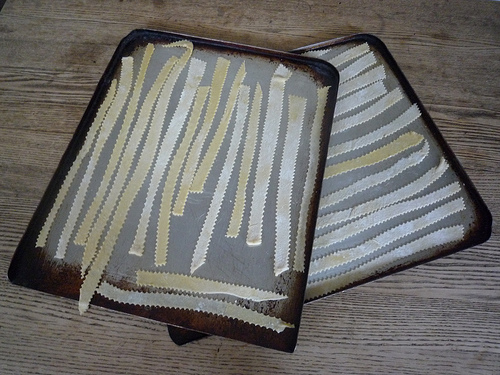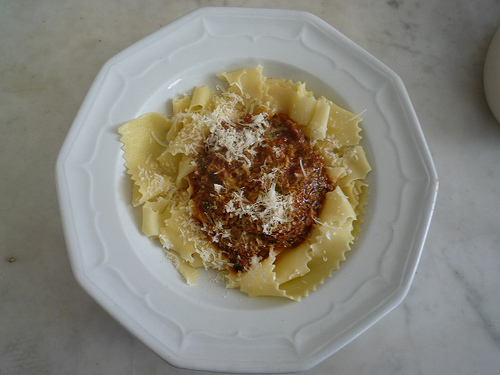-
Posts
5,402 -
Joined
-
Last visited
Content Type
Profiles
Forums
Store
Help Articles
Posts posted by Margaret Pilgrim
-
-
Okay, now I really need clarification. I can't get my arms around this sequence: "add the cream at the last "few" minutes of cooking--don't stir it in too early and let it cook for hours".
So, when should we add the cream (or milk?) When should we start stirring? How many hours?
Perhaps I read too quickly but what recipe did you follow?
-
Bravo, David. I am, as I'm sure others are, interested in your expected results.
-
My kitchen friend is a two-tined fork. Spot-on for fluffing couscous, polenta, rissoto, and...whirling small pasta like orecchiette. They never nest. BUT I also use de Cecco or an organic artisanal brand.
-
Just another example of "keep it simple, stupid" plates. We overthink, overwork and over season much of what we do. To say nothing of over-sauce at serving, the anathema of homeland Italian cooking.
-
-
It sure was hard for me not to add garlic. But, after tasting this morning, I don't miss it a bit. I also thought I'd miss basil etc. but, nope. This sauce is not gravy, but it's definitely going to be added to my cooking rotation.
This is the richest sauce I've ever tasted. You couldn't take more than a couple of bites without pasta (IMO).
Next time I make it, I'll make a much bigger batch.
My husband is thrilled that we've come up with a new way to eat geese and ducks.
Way to go! It is definitely not "gravy".
And you will be thrilled with a duck version. It is swoon-producimg. My favorites are duck, pork, rabbit.
I make probably a gallon a month of various kinds to pass on to grown "kids" who keep it on hand in the freezer. I use wide-mouth jars so they can just thaw the edges and turn out into a saucepan for fast-food dinner.
-
These variations on a theme suggest a corollary of the Unitarian Women's Annual Stew Dinner. 50 women would volunteer to make a batch of beef stew while strictly adhering to a supplied recipe. Of course, there were always 50 completely different dishes on the banquet table.

I think what is lost in this thread is the frequent subtlety of Northern Italian cooking, causing us to want to "spice it up a bit". Many of us grew up on Italian-American recipes with their dependence on garlic, the heavier herbs (marjoram, oregano, bay) and tomato reflecting origins from Rome through Sicily. Lots of Italian food is "quiet". It got boisterous after coming to America.
-
Sorry, no additional details and I don't understand Italian so I was just watching. It was a traditional ragu but had two interesting aspects (or three if you count the use of rabbit) - firstly he deglazed with brandy (and flamed it) not wine, and secondly the caramel. Apart from that it was a standard ragu, the caramel went in at the end. I'd be interested to know how much of the brandy flavour remained in the sauce, and whether it has a particular affinity with rabbit or whether it's just what was handy. I guess one day I'll try it and see if it's for colour, flavour, or both.
Someone mentioned goat - it's traditional in Italy to serve goat at particular religious periods of the year. I guess that if you use goat in a ragu it's no longer ragu alla Bolognese, even if everything else stays the same, but it's certainly delicious! I'd have to be honest and say that in a blind taste test I couldn't tell it from lamb, but I wouldn't be worried either way... Generally the meat from the ragu is served as its own course, and the sauce is served with pasta. This again is interesting to compare with the traditional ragu alla Bolognese, where the sauce is solely intended to be served with pasta. But other regional variations may follow the same basic technique to produce a meat dish, of which the sauce is served with pasta as something of a by-product.
That gives me more ideas--serving the meat as a separate course and the strained sauce with pasta for another course. One could even stretch the theme and do an appetizer with pancetta--sort of a Bolognese tasting menu.
If you are able to remove the meat from the sauce, you are not making Bolognese; you are making Sunday gravy, another worthy cookoff subject.
-
I don't love the idea of "cream". Would you consider doing 3? Adding one with milk?
-
After reading this thread I am still confused about the definition of Ragu and the definition of Bolognese. I always thought a ragu was generally a tomato based meat sauce characterized by a soffrito and long cooking of the meat. Most any kind of meat was acceptable, including goat and rabbit or a mix of meats; you used what you had.
Ragu Bolognese was in my mind a regional ragu that differed by the use of less tomato product and the addition of milk. Very useful if fresh tomatoes are out of season and you don't have any canned tomatoes on hand. Should it be called Bolognese if it doesn't have milk in it? I suppose a case can be made that if you live in Bologna you can call it whatever you want. Straighten me out on this.
I'm with you. Bolognese is a "meat" sauce rather than a "tomato" sauce; always contains milk, never herbs. Tomato intensity is cut by meat broth used to maintain liquidity during the long simmer.
-
In our house, Bolognese Sauce does not require a shopping list. It happens when we have cold-closet and pantry ingredients on hand. More specifically when we have a large chunk of left over steak, roast beef, pork or lamb. Even roast chicken or other fowl. It is a process rather than a recipe. Ergo:
Roughly hand chop meat or meats, yes, we occasionally mix meats. Or process briefly. Chop or process carrots, celery and onions. Measure out a cup of white or, yes, sometimes red wine. Equal quantity of milk. Roughly chop either fresh tomatoes (when they are good) or canned (San Marzano type).
Glaze a heavy pan (aka all-clad) with olive oil. Slowly saute the vegetables but do not color. Add oil if dry. Add chopped meat and color but do not brown. Add wine and reduce to almost dry. Add milk, generous grinds of nutmeg and black pepper, teaspoon kosher salt. Reduce to almost dry. Add tomatoes and their juices. Stir well to combine. Bring to a boil then reduce heat and let simmer on low heat until thick and color mellows to an orange-brown. In a perfect world, let cool and hold in fridge for several days. It gets better with age. Or, freeze in convenient portions.
ETA: While I don't add either to ragu, I have no problem with the judicious addition of either good soy sauce or fish sauce to savory recipes. Very few tasters are able to identify the elusive if even discernible added dimension.
-
-
No, "got" your astute lens on my mind.

-
Would love to have some reports and inside photos. Anybody been?
-
Just don't mention the camera next time....!
There's an old saw that seems to apply here:
"It's easier to receive forgiveness than permission."

And I would suggest one of my mother's favorites:
"Don't bite off your nose to spite your face."
If you are still or in the future become interested again in Campbell's Coworth food, just paste on a smile and go.
-
Also appreciated was the clear and concise text that shared olfactory as well as papillary description. Thanks for the complete "picture".Terrific report and photos David illustrating how important good pictures are.
Thank you Margaret.
So glad to have your seal of approval.
My pleasure.

-
Also appreciated was the clear and concise text that shared olfactory as well as papillary description. Thanks for the complete "picture".Terrific report and photos David illustrating how important good pictures are.
-
FWIW, detailed written description is more informative than a photo stream or photos accompanied by sloppy or purple haze description. Even when stunningly presented, a plate of brown protein can be any one of a dozen pieces of as many kinds of animal, its contrasting sauce or foam equally puzzling.
Precise captions, please.
-
I am not making a round trip journey of nearly seven hours to review a restaurant....
I couldn't agree more. I have, however, done just that to experience food and ambiance.
-
It is not unusual for starred dining rooms in France to prohibit photography. The reasons given range from discouraging downscale kitchens' attempting crass imitation, protecting the visual space of other diners, insuring the ephemeral joy of surprise for future diners.
I would think that most passionate chefs hope that diners visit in order to enjoy a delicious and convivial table with friends and family. All else is media.
-
I regularly make NYTimes 18 hour bread which bakes an hour at 450degrees. I notice that my oven is noticeably cleaner than it was a couple of years ago.

-
Mikael was stabbed and Aurelie beaten in their restaurant last night by a gang, one of whom has been apprehended. They were battered, but hoping to open tonight.
-
I haven't been, and don't see London in my near future, but I do understand the kind of cooking that has been described here by several astute diners. As in music, where it is far more difficult to maintain tone quality while playing exceedingly softly, it is infinitely more difficult to cook and present something with a minimum of handling, cooking and seasoning. It is much easier to augment a product, to add season and sauce and garniture to hide imperfections of sourcing and kitchen technique. Visit any of the more-is-more temples to see what I mean.
-
"Cotswold wild chicken"
What is this?






eG Cook-Off 57: Bolognese Sauce
in Cooking
Posted
Many thanks, nickrey, David and Shelby. It all goes to support the the old-country grandmother authenticity rule: mine is right, yours is wrong. But all delicious.